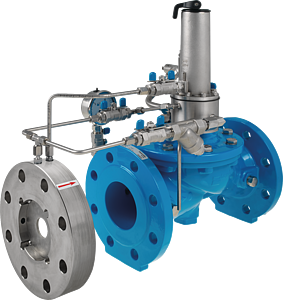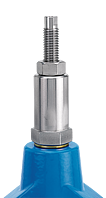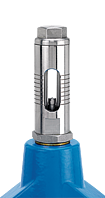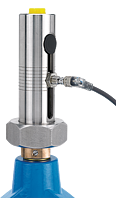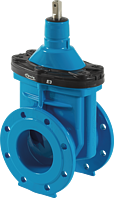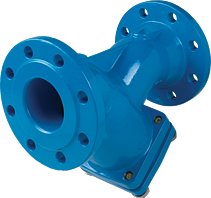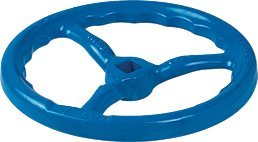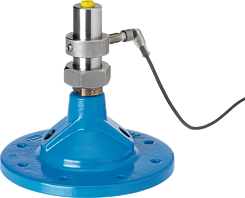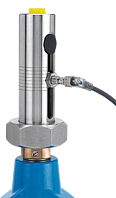1709250000 Pipe break safety device valve for hydraulical control DN 250 PN 10/16
Components
- 1: Main valve
- 2: Ball valve (A, B, C)
- 3: Filter
- 4: Throttle check valve
- 5: Control valve
- 6: Accessories (optional)
- 7: Differential pressure orifice plate
- 8: Pressure gauge with ball valve
- B: DN 40 to DN 150: 40 mmDN 200 to DN 400: 44 mm
- X: 5 x DN line
- Y: 3 x DN line
Add to watchlist
Product attributes
| DN | 250 |
|---|---|
| PN | 10/16 bar |
| L | 730 mm |
| weight | 250.000 kg |
|
NPK No. 411 | 845344 |
| Availability | on demand |
Physical characteristics
- The main valve is a hydraulically operating diaphragm valve. The work energy is the inherent medium.
- Most valve types operate purely hydraulically without any foreign energy.
Application
- To use in drinking water systems (other media after consultation)
- Closing of the line in the event of excessive water flow (burst pipe)
Mode of operation
- The pipe breakage safety valve monitors the volumetric flow rate with the differential orifice plate. In the case of a burst pipe, the volumetric flow rate in the differential orifice plate increases, and the difference in pressure becomes larger. The pipe breakage safety valve is switched and the base valve is closed. The flow control valve can be used to adjust the speed that the valve closes.
Product information
- To calculate the dimensions of the valve please refer to the following information:
- Maximum and minimum inlet pressure (static and dynamic pressure ratios)
- Existing counterpressure
- Maximum flow rate
- Maximum permitted loss of pressure (standard loss of pressure through the measuring orifice and valve 0.5 bar)
- Available line diameters and lengths
- Construction of the valve (straight or angle design)
- For the calculation basis, information on the loss of pressure and the characteristic values of the valve, please refer to the end of Chapter E.
Design
- Design according to DIN EN 1074
- Construction length acc. to DIN EN 558
- Flange mass according to DIN 1092-2, to PN 25 DN 300
- Pressure levels: PN 10 or PN 16 to DN 300, PN 25 to DN 200, higher pressures on request.
- Nominal widths DN 50, DN 80, DN 100 and DN 150 available in angular design
- Nominal widths 1 ½" and 2" with threaded connection (female thread)
- Medium temperature up to 40°C
Installation and assembly
- Shut–off valves should be fitted on both sides of the valve and a dirt trap should be installed on the inlet side of the valve (before the orifice plate). Depending on the installation situation, a mounting/dismounting adapter should be provided. An aeration of the supply system must be provided after the valve.
- The orifice plate must be installed before the valve. It is recommended that the following measurements are taken into consideration:
- X = 5 x DN, distance in front of the orifice plate in a straight line
- Y = 3 x DN, distance after the orifice plate and before the valve, in a straight line
Vantages
- Maintenance-free, non-rusting valve seat
- Pressed-in seat
- EWS-coating according to RAL GSK
more


